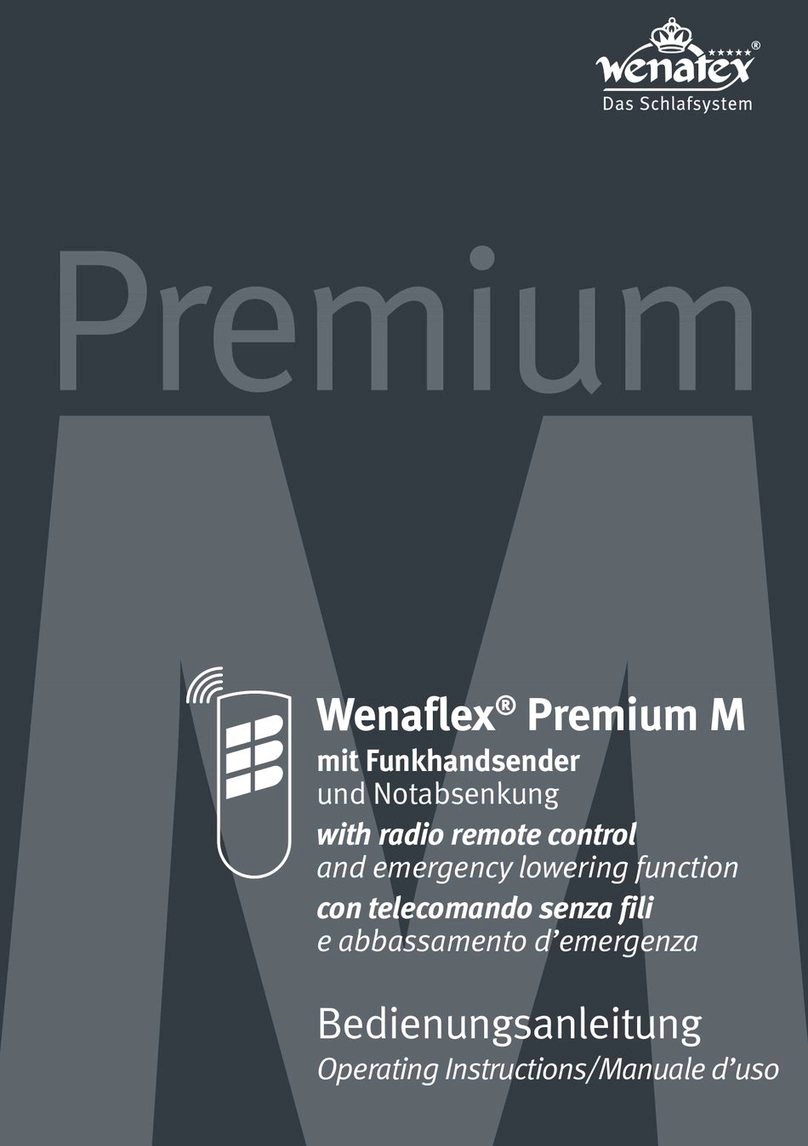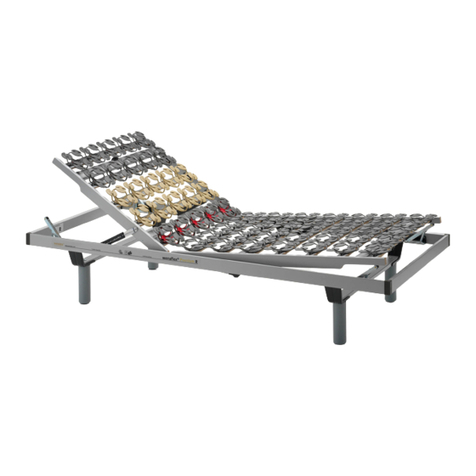
2. Inbetriebnahme und Bedienung
Bitte überprüfen und beachten Sie folgende
Punkte:
• Nach Lagerung oder Transport bei kalter Witte-
rung oder bei starken Temperaturschwankun-
gen ist das Gerät vor der Inbetriebnahme lang-
sam an die Raumtemperatur des Einsatzortes
anzupassen, um Kondenswasserbildung zu
vermeiden. Hat sich Kondenswasser gebildet,
so darf das Gerät frühestens nach einer Warte-
zeit von 12 Stunden in Betrieb genommen
werden.
• Die Transportsicherungen sind zu entfernen
(z. B. Folien, Karton, Klebebänder, usw.).
• Sind am Betteinsatz bzw. am Antrieb/Funk-
handsender Transportschäden sichtbar?
Wenn ja, kontaktieren Sie den Wenatex-
Kundenservice.
• Prüfen Sie vor der ersten Inbetriebnahme, ob
der Antrieb fest mit dem Gestänge xiert ist.
Wenn nicht, kontaktieren Sie den Wenatex-
Kundenservice.
• Ist die Bettkonstruktion für diesen Betteinsatz
geeignet? (Siehe Abb. 1)
Abbildung 1
• Legen Sie den Betteinsatz so in Ihr Bett ein,
dass er rundum gleichmäßigen Abstand zum
Bettrahmen aufweist.
• Stimmen Stromart und Netzspannung in Ihrem
Haushalt mit den technischen Daten überein?
• Stecken Sie den Netzstecker in die Steckdose.
• Überprüfen Sie, ob der Kabelhandsender
angeschlossen ist.
• Achten Sie auf sachgemäße Leitungsführung
des Netzanschlusses und des Steuerkabels
zum Funkempfänger.
• Überprüfen Sie, ob der Funkempfänger ange-
schlossen ist.
• Schützen Sie alle Kabel vor Quetschungen und
anderen Beschädigungen. Ist dies der Fall,
trennen Sie den Netzstecker sofort vom Strom-
netz!
• Der elektrisch verstellbare Betteinsatz dient
ausschließlich zur Veränderung der Lage von
Personen in einem Bett (siehe Abb. 2).
Abbildung 2
• Kopeil und Fußteilsind in gehobener Position
nicht geeignet, um darauf zu sitzen oder zu
stehen (siehe Abb. 3 und 4).
Abbildung 3 Abbildung 4
• Achten Sie darauf, dass sich beim Heben und
Senken des Betteinsatzes keine Personen und
Körperextremitäten unter bzw. zwischen den
mechanischen Bestandteilen des Betteinsat-
zes benden. Es besteht Quetschgefahr!
• Der elektrisch verstellbare Betteinsatz ist nur
für die zuvor beschriebene Anwendung be-
stimmt. Eine andere Verwendung ist unzuläs-
sig und kann zu Unfällen oder Zerstörung des
Gerätesführen. Diese Anwendungen führen zu
einem sofortigen Erlöschen jeglicher Garantie-
und Gewährleistungsansprüche.
• Der elektrisch verstellbare Betteinsatz darf
nicht zum Heben und Senken von Lasten im
handwerklichen undindustriellenEinsatz oder
im häuslichen Gebrauch verwendet werden.
• Der elektrisch verstellbare Betteinsatz darf
nicht in einer Umgebung, in der mit dem Auf-
treten von entzündlichen oder explosiven
Gasen oder Dämpfen (z. B. Anästhetika) zu
rechnen ist, verwendet werden.
• Der elektrisch verstellbare Betteinsatz darf
nicht in feuchter Umgebung (Oshore-An-
lagen, Meeresbereich) oder im Freien verwen-
det werden.
• Der elektrisch verstellbare Betteinsatz darf
nicht in Flugzeugen und anderen Lufahrzeu-
gen verwendet werden.
• Der elektrisch verstellbare Betteinsatz darf
nicht in Atomkrawerken verwendet werden.
wenaFlex®Premium M mit Funkhandsender 5
Deutsch





























